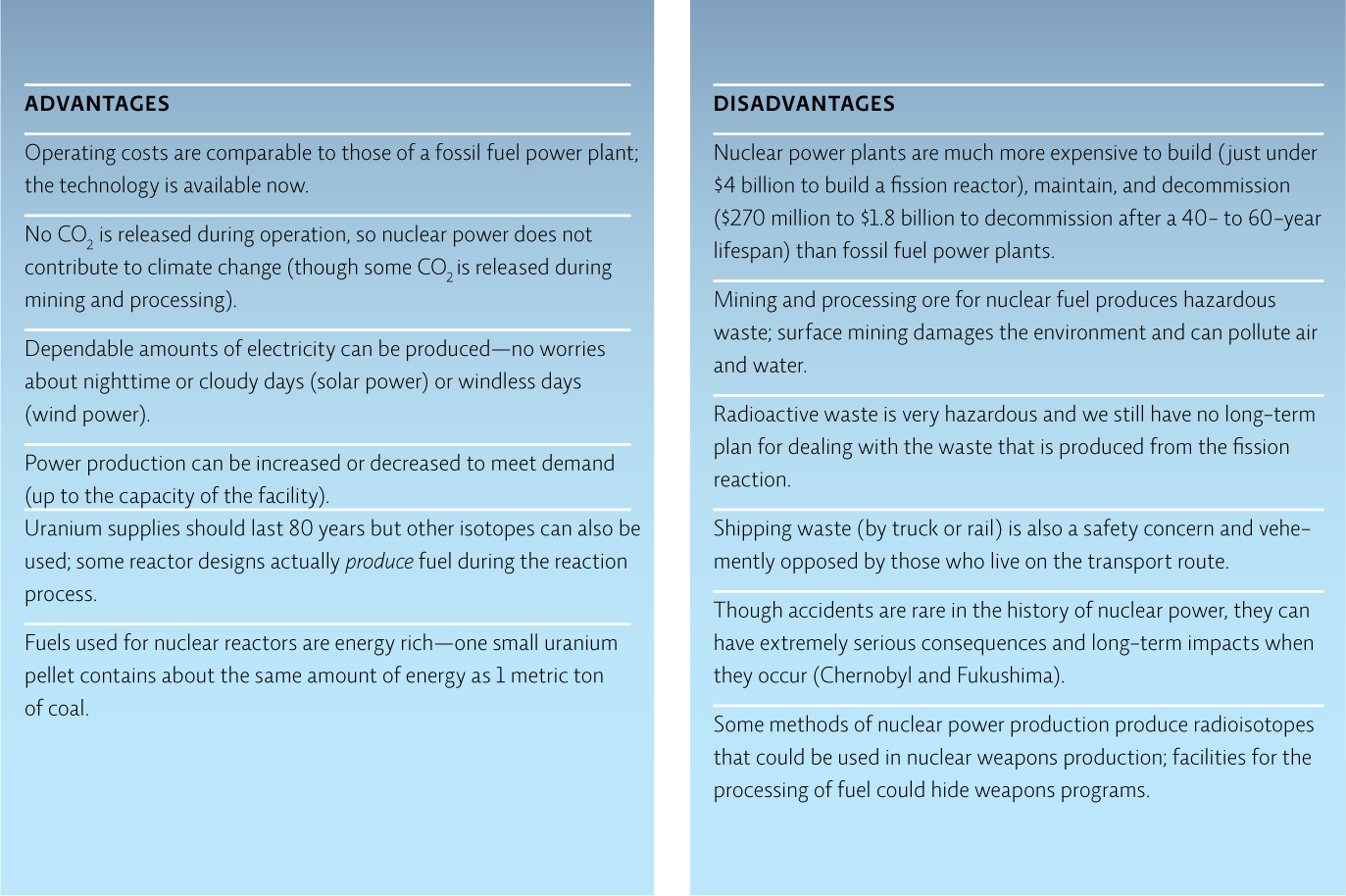23.8 Will nuclear power play a role in future energy?
The March 2011 tsunami would become the most expensive natural disaster in human history, with losses estimated at $300 billion. In its wake, countries around the world began rethinking their plans to expand their own nuclear energy programs. Germany resolved to phase out all of its nuclear power plants by 2022. Austria, Italy, and Switzerland also reconsidered. While Canadians were horrified by the tragedy in Japan, there was little backlash against nuclear power in Canada. Government agencies reassured the public that all of our reactors are located in low-earthquake-risk regions and are built to meet “seismic standards.” However, most reactors are also located in highly-populated areas, such as the Durham region east of Toronto. Critics asserted that, while a nuclear emergency might be unlikely, if one did occur, millions of people would be at risk. Proponents, meanwhile, held fast to their contention that nuclear power could be used safely and would be an essential, unavoidable part of weaning the planet from its fossil fuel dependence.
Meanwhile, back in Japan, just 2 months after the quake and tsunami, the prime minister responded to public pressure and global criticism by calling for a temporary shutdown of one nuclear plant in the country’s centre, where scientists have estimated an 87% chance of a big quake sometime in the next three decades. Other plants that were closed for routine maintenance were told to hold off on reopening, so that, by summer’s end, less than a third of Japan’s 54 reactors were still running.
The course change was short-lived. Once factory owners began warning that such drastic power cuts would quickly lead to a recession, many of the deactivated power plants sprung back to life by order of the same prime minister who had closed them. Ultimately, the country’s leaders would agree to close some of its oldest plants but leave most—36 out of 54, by one estimate—up and running for the foreseeable future. One official told the New Yorker that anything else would be “idealistic but very unrealistic.” Speaking at an October 2011 forum sponsored by the American Association for the Advancement of Science, Gregory Jaczko, chairman of the NRC, predicted that the impact of Fukushima on the long-term development of nuclear power will be minimal.
430
Less than a year after the fires had cooled, experts would agree that the Daiichi disaster was something of a draw. “People who support nuclear energy can’t argue anymore that the risk is nonexistent,” says Powers. “But at the same time, neither can opponents say that a meltdown would automatically result in a zillion immediate casualties.”
In a paper published before the disaster at Fukushima, British nuclear engineers Robin Grimes and William Nuttall argued that nuclear power could enjoy a “renaissance” and increase its contribution to electricity production in the future, if only we improved our nuclear technology. They pointed to new “third generation” BWR and PWR reactor designs (and others) available now, and other technologies (“fourth generation”) in development that should be safer and more efficient, producing more electricity with less fuel. Some designs also produce less waste material that could be used to make nuclear weapons, reducing concerns about weapons proliferation.
The third-generation designs in use today are safer, according to safety assessments, and include more fail-safe responses (technical responses that automatically kick in if a problem occurs). But of course, the 2011 earthquake and tsunami have illustrated the need to reevaluate the potential damage of natural disasters. The renaissance would also require better waste-handling options, including the reprocessing of spent fuel (which would decrease the waste produced and increase overall efficiency).
Given the problems associated with fossil fuels, it is likely that nuclear power will continue to have a place in our energy mix. But in making choices about how to pursue our energy future, we must consider the costs and benefits of all our energy options. A “benefit analysis” must evaluate how well a particular energy source meets our energy needs. A “cost analysis” must consider not just the monetary cost of getting kilowatts delivered to our homes; it must also include the environmental and social costs associated with every step of the energy source’s life, from acquisition to production to delivery. In addition, as mountaintop removal, oil spills, climate change, and Fukushima demonstrate, there is also a risk assessment that must take place. We must ask two very crucial questions: how risky is the venture (an assessment we can do with at least some degree of accuracy) and how much risk are we willing to take? [infographic 23.8]

431
“There is definitely a certain weighing that has to take place,” says Powers. “Global warming on one hand, nuclear accidents like Fukushima on the other.”